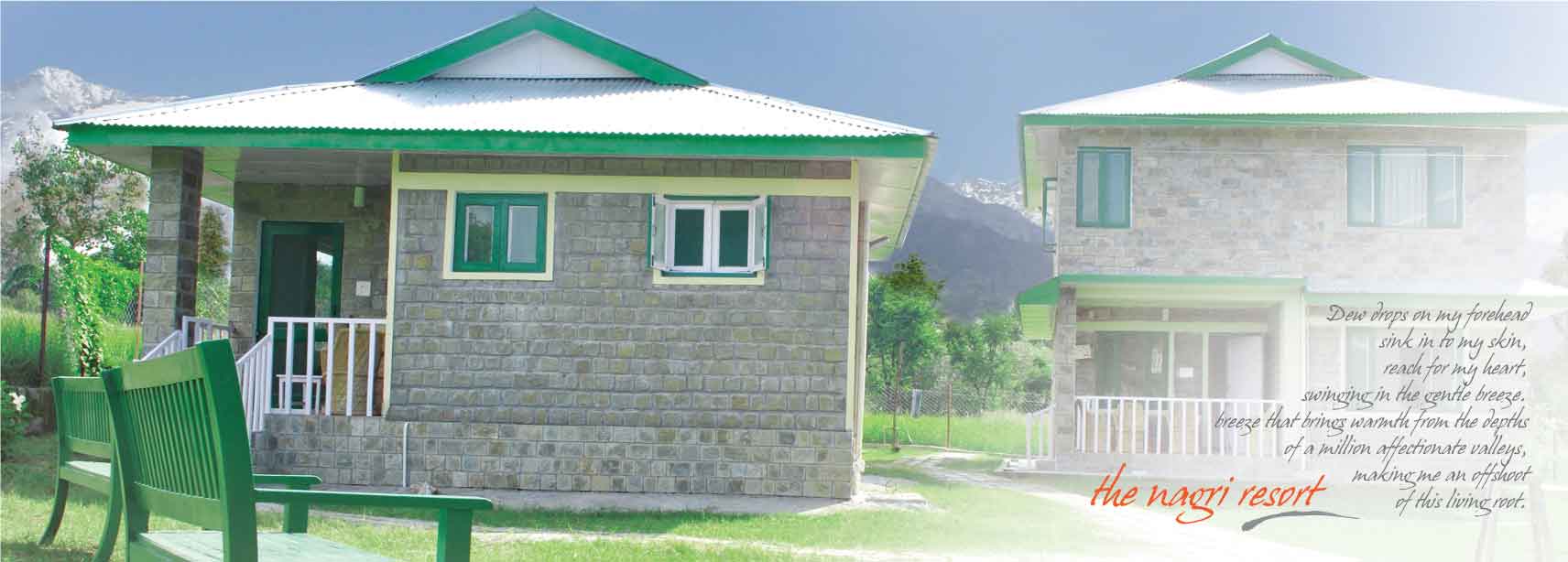|
Home
 |
|
|
|
 |
|
 Location 1:Sidhbari
Dharamshala H.P. Location 1:Sidhbari
Dharamshala H.P.
Location 2:
Ground flour Alfa Mall Bhagsunag(Mcleodganj) |
 |
|
Gallery no 1 displaying water colour by
Elsbeth Buschmann |
|
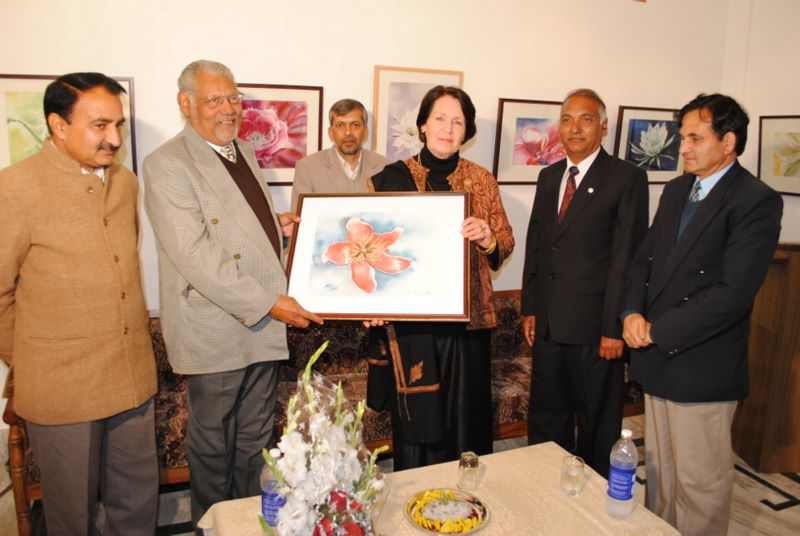 |
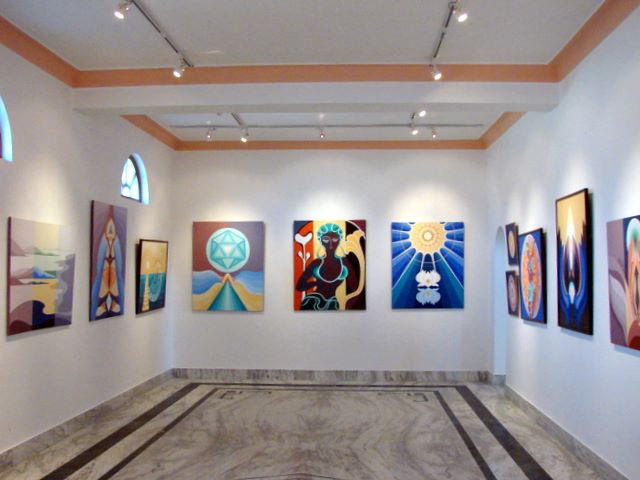 |
| Opening ceremony of Naam Art
Gallery |
Gallery no 2 |
|
The permanent exhibition in ‘NAAM ART GALLERY’
shows paintings by
Elsbeth Buschmann - watercolours and acrylics - and oil
paintings by Alfred W. Hallett.
Elsbeth Buschmann, is a professional painter
from Germany, having studied painting in London and Paris .She
lived in many countries where she held exhibitions, especially
in the USA where she received various awards. Her paintings are
in private collections in Germany, USA, Scotland, India and
Switzerland. In India she held solo exhibitions at AIFAX, New
Delhi and TAG, the Art Gallery of the Taj Mahal Hotel, Mumbai.
She also took part in ‘The Himalayan National Exhibition of Art’
and was awarded.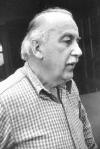
A.W.Hallett is a very well renowned painter from England. He
studied art in London and participated in two exhibitions of the
Royal Academy of Art, London which entitled him to become a Fellow
of the Academy. He held various international exhibitions. He
lived over 40 years at Dharamsala and became very popular in
Himachal Pradesh. Many of his paintings are owned by the
government of Himachal Pradesh. A.W. Hallett held a special
interest in the culture and scenery of Himachal Pradesh which are
the main elements of his work. He passed away in 1986 at
Dharamsala.. The display of his paintings in ‘NAAM ART GALLERY’
are a tribute to this great painter.
Gallery Timing: 10 am to 7 pm (Monday closed)
|
|
|
|
|
Related links |
|
German artist opens 'NAAM' art gallery in Dharamsala |
Dharamsala
is situated in the
northern Indian state of 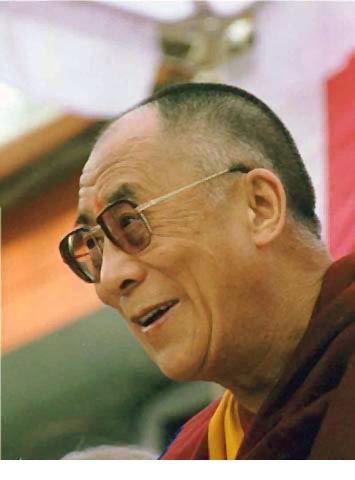 Himachal Pradesh. It lies
on a spur of the Dhauladhar range, the Pir Panjal region of the Outer
Himalayas; and commands majestic views of the mighty Dhauladhar ranges
above, and the Kangra Valley below. Dhauladhar means "white ridge" and
this breathtaking, snow-capped range rises out of the Kangra Valley to a
height of 5,200 meters (17,000 feet). Image by Dr B C Khanna The
mountains dominate the scenery in McLeod Gunj. They form a treacherous
range creating unpredictable weather, but passes of 2,400 meters (8,900
feet) provide route for the herdsmen of the Ravi Valley beyond. The Kangra
Valley is a wide, fertile plain, criss-crossed by low hills. The scenery
touched the heart of a British official who wrote: "No scenery, in my
opinion, presents such sublime and delightful contrasts. Below lies the
plain, a picture of (Image by Dr B C
Khanna) rural loveliness and
repose... Turning from this scene of peaceful beauty, the stern and
majestic hills confront us... above all are wastes of snow to rest on."
Dharamsala is divided into two very different parts. Kotwali Bazaar and
areas further down the valley (at the average height of 1,250 metres) are
called Lower Dharamsala, while McLeodGunj (at the height of nearly 1,800
metres) and surrounding areas are known as
Upper Dharamsala. McLeodgunj is nine
kilometers by bus route and four kilometres by taxi route up the hill from
Kotwali Bazaar.While inhabitants of Lower Dharamsala are almost all
Indians, McLeod Gunj is primarily a Tibetan area. McLeod Gunj
is surrounded by pine, Himalayan oak, rhododendron and deodar forests. Himachal Pradesh. It lies
on a spur of the Dhauladhar range, the Pir Panjal region of the Outer
Himalayas; and commands majestic views of the mighty Dhauladhar ranges
above, and the Kangra Valley below. Dhauladhar means "white ridge" and
this breathtaking, snow-capped range rises out of the Kangra Valley to a
height of 5,200 meters (17,000 feet). Image by Dr B C Khanna The
mountains dominate the scenery in McLeod Gunj. They form a treacherous
range creating unpredictable weather, but passes of 2,400 meters (8,900
feet) provide route for the herdsmen of the Ravi Valley beyond. The Kangra
Valley is a wide, fertile plain, criss-crossed by low hills. The scenery
touched the heart of a British official who wrote: "No scenery, in my
opinion, presents such sublime and delightful contrasts. Below lies the
plain, a picture of (Image by Dr B C
Khanna) rural loveliness and
repose... Turning from this scene of peaceful beauty, the stern and
majestic hills confront us... above all are wastes of snow to rest on."
Dharamsala is divided into two very different parts. Kotwali Bazaar and
areas further down the valley (at the average height of 1,250 metres) are
called Lower Dharamsala, while McLeodGunj (at the height of nearly 1,800
metres) and surrounding areas are known as
Upper Dharamsala. McLeodgunj is nine
kilometers by bus route and four kilometres by taxi route up the hill from
Kotwali Bazaar.While inhabitants of Lower Dharamsala are almost all
Indians, McLeod Gunj is primarily a Tibetan area. McLeod Gunj
is surrounded by pine, Himalayan oak, rhododendron and deodar forests.
 |
The main crops grown by local Indians in the valleys below
McLeod Gunj are rice, wheat and tea. Today, streams of Tibetan
refugees from all over the world flock to McLeod Gunj to receive
blessings and teachings from His Holiness the Dalai Lama.Western and
Indian tourists and scholars come here to see the rebirth of an
ancient and fascinating civilization. The high altitude and cool
weather contribute physically to this recreation of the original
Tibetan environment. Dharamshala pulsates with the sights and sounds
of old Tibet. Though certainly more modern, life is basically
Tibetan in character. Shops strung out along the narrow streets of
McLeod Gunj sell traditional Tibetan arts and handicrafts and the
aroma of Tibetan dishes lingers in the air. |
|
Bhagsunag waterfall |
|
H.H.The Dalai Lama
The Dalai Lama was born to a Mongour farming family as Lhamo
Thondup (also spelled Lhamo Dhondrub among other spellings) on July 6,
1935, in the far north eastern province of Amdo in the village of Taktser,
a small and poor settlement which stood on a hill overlooking a broad
valley. His parents, Choekyong and Dekyi Tsering, were moderately wealthy
farmers among about twenty other families, some ethnic Han Chinese, making
a precarious living off the land raising barley, buckwheat, and potatoes.
He was the fifth of nine children, the eldest child being his sister
Tsering Dolma, who was eighteen years older than he. His eldest brother,
Thupten Jigme Norbu, has been recognized as the reincarnation of the high
lama, Takser Rinpoche. His other elder brothers are Gyalo Thondup and
Lobsang Samten. When the Dalai Lama was about three years old, a search
party was sent out to find the new incarnation of the Dalai Lama. The
thirteenth Dalai Lama had turned to face the northeast while he was dying,
indicating the area where the next Dalai Lama should be found. Shortly
afterwards, a senior lama had a vision of a house with strangely shaped
guttering. They found a house similar to the one in the vision after
extensive searching. They presented the boy they found, Lhamo Thondup,
with various relics and toys of the previous Dalai Lama. It is claimed
that he recognized them by saying, "It's mine, it's mine!"
Lhamo Thondup was recognised as the reincarnation of the Dalai Lama
and renamed Jetsun Jamphel Ngawang Lobsang Yeshe Tenzin Gyatso ("Holy
Lord, Gentle Glory, Compassionate, Defender of the Faith, Ocean of
Wisdom"). Tibetan Buddhists normally refer to him as Yeshe Norbu, the
"Wish-fulfilling Gem", or just Kundun, "the Presence". In the West he is
often called "His Holiness the Dalai Lama", which is the style that the
Dalai Lama himself uses on his website.
Tenzin Gyatso began his
monastic education at the age of six. At twenty-five, he sat for his final
examination in the Jokhang Temple, Lhasa, during the annual Monlam
(prayer) Festival in 1959. He passed with honours and was awarded the
Lharampa degree, the highest level geshe degree (roughly equivalent to a
doctorate in Buddhist philosophy).
His Holiness'
Residense
The Residence
of His Holiness Dalai Lama is opposite the Tsuglag Khang, or the Central
Cathedral, which is about ten minutes' walk from McLeod Gunj. Time
permitting, His Holiness receives visitors in public audiences. Visitors
can apply for public audiences at the Branch Security Office in McLeod
Gunj, near Hotel Tibet. Applications for private audiences, however, need
to be made in writing to His Holiness' Secretary several months in
advance.
Exploring Tibetan
Culture
The cultural
life in Dharamshala is colourful and rich in tradition. The fairs and
festivals are occasions for relaxation. To the local Indian traditions,
Tibetan refugees have added their own festivals such as Losar (Tibetan New
Year), and His Holiness the Dalai Lama's birthday which is celebrated on
July 6 with the performance of Tibetan, Nepali and Gaddi dances revealing
the cultural mosaic that McLeod Gunj is. More recently, tourists and
students from the west have added rock music, stage musicals and
contribute other Western influences to this melting pot of peoples and
cultures.
The Library of Tibetan Works
And Archives
The LTWA is located in the Central Tibetan Administration complex.
It was established in 1971 as a repository for ancient cultural objects,
books and manuscripts from Tibet.
The Library has eight
departments: research and translation; publications; oral history and film
documentation; reference (reading room); Tibetan studies; Tibetan
manuscripts; a museum and a school for thangka painting and wood-carving.
LTWA also has a team of Tibetan scholars who are engaged in research,
translation, instruction and the publication of books.
Since its
founding, the Library has acquired a reputation as an international centre
for Tibetan studies. To date, more than five thousand scholars and
research students from over thirty countries have benefited from this
unique educational institution. LTWA offers regular classes in Buddhist
philosophy and the Tibetan language. A schedule of courses is available
from the Library office.
Apart from books and booklets on diverse
aspects of Tibetan culture, the Library brings out regular publications,
among which The Tibet Journal is pre-eminent. For research scholars and
students, the Library offers hostel accommodation on a
first-come-first-served basis.
Tibetan Institute Of Performing
Arts
TIPA is about
fifteen minutes' walk from McLeod Gunj. Established in 1959, TIPA was the
very first institution in exile. It is the home of lhamo, the arrestingly
colourful and unique folk opera of Tibet. TIPA preserves a wide repertoire
of musical, dance and theatrical traditions from Tibet. To balance the
weight of tradition in its repertoire, the institute has a modern Theater
Troupe which puts on contemporary plays. TIPA also maintains its own
workshops for making costumes, masks and musical instruments.
TIPA
trains instructors who are sent out to teach music and the performing arts
at schools and settlements throughout India and Nepal. It also runs a
schools where a mix of modern academic and traditional Tibetan education
is provided to children who are, in addition, trained in Tibetan music,
dancing and acting from an early age. Of late, TIPA has started a special
programme to teach the Tibetan performing arts to
non-Tibetans.
TIPA holds an annual Folk Opera Festival in April. A
number of folk operas, dance programmes, plays and concerts are presented
on this occasion. It is always an exciting time to be in Dharamshala. On
important national holidays throughout the year other performances are
given. An annual competition among students is held in May or June.
Special shows can be arranged for visiting groups if the Institute's
office is notified in advance. A standard fee is charged for filming
shows.
Artistes from TIPA have performed in many parts of the
world. Plans are underway to open a museum of Tibetan folk culture where
the rich range of regional costumes, musical instruments, masks and arts
will be displayed.
The Norbulingka Institute
The Norbulingka Institute of Tibetan Culture was founded by
the Department of Religion and Culture to preserve and promote Tibetan art
and culture in exile. It derives its name from the His Holiness the Dalai
Lama's beautiful summer residence, the Norbulingka (Jewel Garden), set in
parkland two kilometers from Lhasa. Fearing for the future of Tibet's
cultural heritage, the Seventh Dalai Lama, Kelsang Gyatso, established
institutes of arts and science there in 1754.
Today, with
occupied-Tibet undergoing the bleakest period in its history, the
Norbulingka Institute in Dharamsala has taken the initiative to preserve
the roots of Tibetan culture in exile. The institute is sited in a scenic
valley below Dharamsala. When completed, it will include a Centre for
Higher Tibetan Learning.
Literature And
Lectures
The Tibetan
community in Dharamsala publishes a number of magazines and journals in
several languages. The Library publishes The Tibet Journal, a scholarly
and international journal on Tibetan culture. The monthly Sheja and weekly
Tibetan Freedom in the Tibetan language are published by the Department of
Information and International Relations. This department also publishes
Tibetan Bulletin, a bi-monthly magazine in English, Tibbat Desh, a
bi-monthly in Hindi, and Tibet Bulletin, a bi-monthly in Chinese. Tibetan
Youth Congress brings out Rangzen in both Tibetan and English. The
Institute of Buddhist Dialectics publishes Lhaksam Tsekpa to interpret the
broad issues of western political thought and ideas. The Department of
Religion and Culture publishes Cho-Yang, a glossy magazine on culture and
Buddhism. Amnye Machen Institute publishes yearly Cairn and Lungta in
English.
Tibetan Review, an independent monthly journal in English,
is published from Delhi and is read by Tibetans all over the world. This
publication represents an attempt by the Tibetan community in exile both
to interpret the contemporary world for themselves and to carry the issue
of Tibet to the world at large.
Tibetan Medical
Tradition
Over a period
of 2,500 years Tibetans have perfected a sophisticated medical tradition
based on the holistic concept of mind and body. It maintains that disease
or disorders in the human body are caused when there is a disequilibrium
of psychological and physical energies. Delusion, hatred and attachment
results in ego (translated also as "I" consciousness), which in turn
disturbs the psychological energy balance, while improper food, behaviour
and bad environment disturbs the physical energy balance.
Tibetan
doctors would normally follow three methods of diagnosis: visual,
interrogation and pulse-reading. Sometimes, they may be able to tell your
ailment by merely asking the symptoms, followed by a pulse-reading and a
look at your tongue or eyes. However, it is believed that diagnosis is
more accurate if these methods are accompanied by a urine
test.
Tibetan medicines normally come in hard pills or powder, and
most are extremely bitter in taste. Their ingredients are predominantly
herbal, although animals products, precious stones and metals are also
used. The stones and metals are burned and de-toxified through an
intricate and secret process of alchemy.
Over the years, Tibetan
medicine has proved most effective in curing various chronic diseases. Its
effectiveness in curing hepatitis, according to some westerners, is
miraculous. Tibetan medicine is also known for its efficacy in curing
chronic sinus-related diseases, although one has to be on medication for a
long time.
There are three clinics for traditional Tibetan
medicine in McLeod Gunj: the Branch Clinic of the Tibetan Medical
Institute, Dr. Yeshi Dhonden's Clinic and the Dr. Lobsang Dolma Khangsar
Memorial Clinic. However, the Tibetan Medical and Astro Institute is the
major institution and is located near Gangchen Kyishong, about five
minutes' walk below the Library
|
DIVYA HIMACHAL
AWARD FOR EXCELLENCE TO SHRI
ANUPAM KHER Read mor |
| |
|
The Gaddi Women's Self-help
Society
An Himalayan Women’s Association in India
Dharmkot and
Baal are small mountain
villages in the Himalayan state of Himachal Pradesh.
They are
inhabited by a population of half-nomadic Hindu
shepherds, the Gaddis, who speak their own
language and have their own traditions and occupations.
Since 1996, a group of women from these remote mountain hamlets
are working and learning together in a local association,
“The Gaddi Women's Self Help Society."
They are women who never had a chance to go to school, widows in
desperate need to support their family, newly graduated young women
in search of decent employment, Isabelle Pompignat Mahendroo,
38 and a teacher in France, is presently on an extended sabbatical
with the purpose of educating and helping the tribal women of
Himalayan regions to be
self-reliant.
Read more....
GADDIS
-THE NOMADS |
|
Gaddis are the nomads of
the lower ranges of the Himalayas. Their mobile Bashas exist in
Jammu and Himachal Pradesh especially on the plateau of the ranges
situated on both sides of the river
Ravi. Read more... |
| |
| Harmonizing with the
moon
Have you ever thought how deeply we are affected
by the moon's cycles? With this understanding we can learn how to
keep healthy and how to get the best results out of planting your
garden or simply feeling more balanced within yourself and your
surroundings. Courses take place every Sunday from 3 - 5 pm at House
Om Tara on the footpath between Bhagsunath and Dharamkot.
For
further information contact:- Om Tara Dharamkot Phone:221365 |
| |
|

|
|
Mcleodganj |
| |
|
Paragliding in Kangra valley:- "I really enjoyed my flight. The conditions at
Bir and Billing are excellent". Germany's top paraglider Norman
Lausch, who won the Pre-world Cup-2002 said "I have enjoyed every
minute of my paragliding here and I would love to be here
again". Read
more....
|
|
The Tibet Museum
Location:- Near
Buddha temple Mcleodganj. Timing :- 10.00 am to 6.00 pm
Closed on Monday.
The Tibet
museum was established with the
aim of presenting Tibet's history and visions for its future through
texts, photographs; videos and installations. The main exhibition,
A Long Look Homeward; features prominently in the
museum. It is divided into two sections: the first section presents
the Chinese occupation of Tibet and its results; the second section
displays Tibet's history and institutions before the occupation and
hopes for its future. The exhibition is the joint work of eleven
Tibetan curators, each of whom narrates a different aspect of
Tibet's history through their personal stories, selected photographs
and historical data. The museum hosts a testimony corner where
Tibetans can provide names of relatives and friends who have died as
a result of the Chinese occupation of
Tibet.
More
Information |
| |
| Yungchen Lhamo is a Tibetan singer living in exile |
|
Onstage, Yungchen's eyes search deep into the audience, as if
recalling some distant melody, with notes emanating from a powerful
center to the far reaches of the venue in what reviewers have aptly
termed "a voice from the skies." Her songs explore traditional
Tibetan themes of spiritual pilgrimage, soul-searching and a delight
in the natural environment. For example, lines from the song "Par
Panee Dawa Shar" from the album Tibet, Tibet intone. Read more....
|
| |
Dalai Lama gives up freedom
dream:-
I once again want to reassure the
Chinese authorities that as long as I am responsible for the affairs of
Tibet we remain fully committed to the Middle Way Approach of not seeking
independence for Tibet and are willIng to remain within the People's
Republic of China. Read more....
Birds
of Kangra by Jan Willem den
Besten Published by: Moonpeak Publishers
and Mosaic Books Rs.395/- Ranging from 600 to over 4,000 m., the old Kingdom (now District)
of Kangra has a remarkable range of scenery and habitats and an already
impressive list of 555 bird species.
Read more...
|
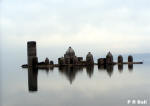 Ruins Of
Bathu Temple Ruins Of
Bathu Temple
Three kilometres east of
Dhameta, a small town in Kangra, there stands a cluster of antique,
unique, tall temples which remain dipped in water for eight months:
but stand exposed to the human eye only during
Marchto June:Read more
|
Dhauladhar Photo Gallery
|



